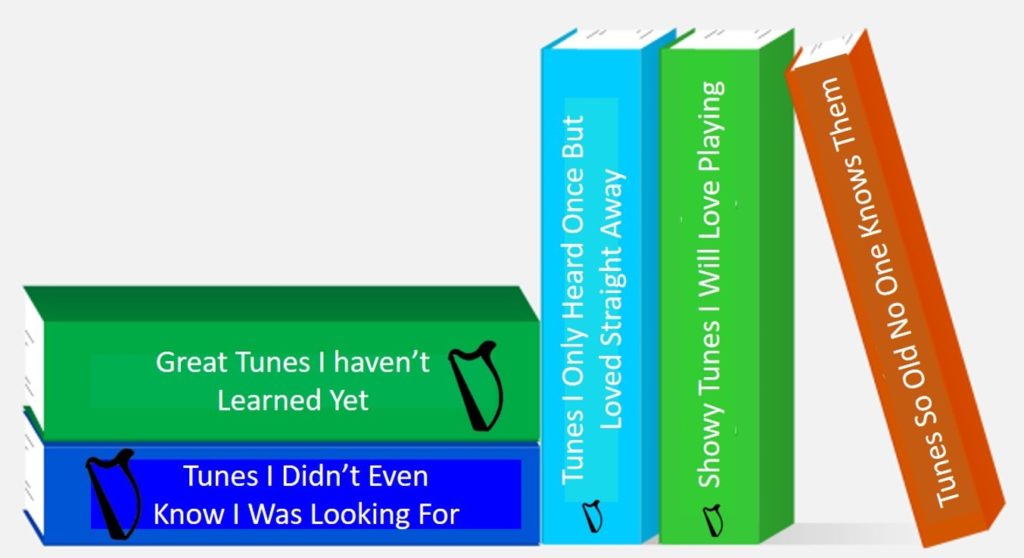I often get asked about tunes, their provenance, their history – in other words, where do they come from? Whether you are just generally curious, preparing for a Scottish Harp competition, or you simply want to correctly catalog your tunes, knowing where the tunes come from can tell you a lot.
First the easy answer – tunes come from all over and are held everywhere (and sometimes nowhere). Many people learn the tunes they pick up in lessons or workshops, enjoy them immensely and go on. Some learn tunes from popular books (such as Sylvia Woods’ many collections or the copious books available from MelBay, Afghan Press* and others) and play them for their own enjoyment. Some musicians learn tunes, play them, and are there for the tune and nothing more. Take off your judgment hat – because there is nothing wrong with that!
 The second answer is a little more nebulous – tunes are everywhere. Some are breathtaking, but difficult to find and others are in every book you pick up (or so it seems) – so where do you find new tunes? Here are seven places to look for your next best loved tune:
The second answer is a little more nebulous – tunes are everywhere. Some are breathtaking, but difficult to find and others are in every book you pick up (or so it seems) – so where do you find new tunes? Here are seven places to look for your next best loved tune:
- You can go to workshops – some workshop tutors are known for their scholarly approach to the tunes and you can learn a great deal at these events.
- You can listen, listen, listen. Find tunes you like being played (and remember to look beyond the harp – there are spectacular tunes out there being presented by pipers, fiddlers, whistle player, concertina, guitar, piano – it’s the tune that’s the thing, the instrument is simply the vessel.
- You can hunt up stuff on the internet Part I – there are a lot of interesting nooks and crannies in the web, patience, perseverance, and a good scratch pad are all you need (the scratch pad is to note the search terms you have already tried and to capture ideas for additional search terms as you go.
- You can hunt up stuff on the internet Part 2 – there are also some easy to find caches of tunes including thesession.org or www.traditionalmusic.co.uk/ or abcnotation.com. these are a bit “wiki-er” so they are a great place to start but if you are searching for authenticity, I’d suggest keeping on looking after you find a tune you like.
- You can hunt up stuff on the internet Part 3 – YouTube – while this might be a corollary of the first bullet, you can often find a couple of different renditions of a tune (which for me makes it easier to “hear” the melody). This works best if you look for a specific tune title and then daisy chain yourself through a bunch of links.
- You can chat up a music librarian or the reference librarian at the local university or community college – it’s amazing what is in those libraries. Of course this is much easier if you live near a music school but, don’t let those plain facades fool you, libraries hold some amazing stuff!
- You can build your own assemblage of published collections books. There are loads of collections, printed in various ways (I have hardbound, softcover, pdf). Some are old (like use gloves and turn pages ever so carefully old) and some are new (like smell the ink new). Some are noted for piano, fiddle, pipes – remember it’s the tune that’s the thing so the notation just gives you an idea where to go. Many of the collections include other important information that is helpful – the story of the tune, the composer, the times, all of which might be helpful for arranging the melody when you decide to present it. And you know, the appropriate number of books to own is much like the appropriate number of harps – one more! You’ll find these collections on line, in (regular) bookshops, and in used book shops.
Do your homework and you will be delighted to find your next favorite tune!
* I don’t have the good sense to do affiliate marketing so this is just my opinion – there’s no kickback from Sylvia or Mel Bay or Afghan Press, this is simply an observation.